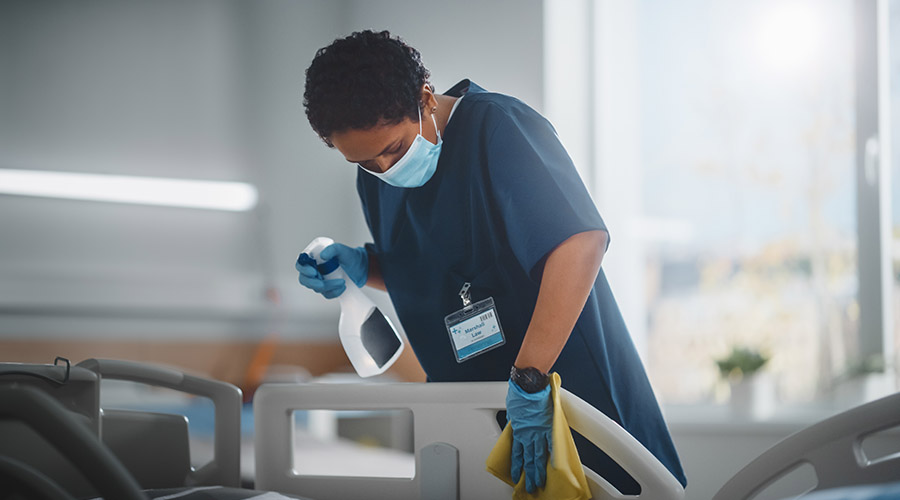In 2020, the U.S. Centers for Disease Control and Prevention (CDC) published a document to address the cleaning and disinfecting of the “near patient” surfaces in healthcare facilities. In the document, entitled "Reduce Risk from Surfaces,” the CDC says there is more to cleaning and disinfecting than meets the eye. The document includes six core components of an effective strategy for breaking the chain of infection as it relates to surfaces and patient equipment.
In December 2023 the Joint Commission alerted hospitals that on July 1, 2024, a new and revised infection control chapter would require the integration of the six core components in daily cleaning and disinfecting of a patient’s bed and 36 inches around it.
Surfaces contaminated with microorganisms can serve as reservoirs of potential pathogens. Many of these microorganisms are continuously shed or spread by direct skin contact onto surrounding environmental surfaces. Contamination of hard and soft surfaces — such as bedrails, bedding, privacy curtains, over-bed tables and call-buttons — and reusable patient-care equipment that is moved between rooms can lead to:
- transmission to the next patient who occupies the room or uses the equipment or
- contamination of the hands or clothing of healthcare personnel leading to transmission to other patients.
Therefore, cleaning and disinfection of environmental surfaces is fundamental to reduce potential contribution to healthcare-associated infections (HAI). Inadvertent exposures to environmental opportunistic pathogens may result in infections with significant morbidity or mortality.
Related: Mandating a Patient's Right to a Clean Room
No standards exist requiring a hospital room to be free of bacteria or viruses in sufficient numbers to cause an infection. Finding evidence for cleaning is compromised by the fact that modelling HAI rates against arbitrary measurements of cleaning and cleanliness requires universal standards, and these are not yet established. Hospitals also overlook the distinction between cleaning — soil removal — and cleanliness — soil remaining.
In the absence of a universal standard for cleaning and cleanliness of the near-patient environment, managers should adopt the six core components:
- Integrate cleaning and disinfecting surfaces into the facility’s safety culture.
- Educate and train staff who are responsible for environmental surfaces and patient care equipment.
- Select appropriate cleaning and disinfection technologies and products. Pay attention to the equipment, furniture and finishes’ manufacturer instructions for cleaning and disinfection when selecting a hospital-approved disinfectant or cleaning products. Select non-corrosive and non-toxic products to be safe.
- Standardize setting-specific cleaning and disinfection protocols.
- Monitor effectiveness and adherence to cleaning and disinfection practices. Managers should include direct observation and invest in technology that measures the cleanliness of non-critical surfaces and equipment.
- Provide feedback on adequacy and effectiveness of cleaning and disinfection to staff and stakeholders by routinely scheduling reviews to identify achievements and opportunities for improvement.
The Joint Commission and the CDC realize that HAIs surged during the pandemic, in some cases erasing a decade of progress preventing them. In other words, the focus on one viral infection appears to have distracted from the fight against other patient safety hazards. Managers and staff must do no harm.
J. Darrel Hicks, BA, MESRE, CHESP, Certificate of Mastery in Infection Prevention, is the past president of the Healthcare Surfaces Institute. Hicks is nationally recognized as a subject matter expert in infection prevention and control as it relates to cleaning. He is the owner and principal of Safe, Clean and Disinfected. His enterprise specializes in B2B consulting, webinar presentations, seminars and facility consulting services related to cleaning and disinfection. He can be reached at darrel@darrelhicks.com, or learn more at www.darrelhicks.com.

 Rethinking Strategies for Construction Success
Rethinking Strategies for Construction Success From Touchless to Total Performance: Healthcare Restroom Design Redefined
From Touchless to Total Performance: Healthcare Restroom Design Redefined New York State Approves $53M Construction Program at Niagara Falls Memorial Medical Center
New York State Approves $53M Construction Program at Niagara Falls Memorial Medical Center How Health Systems Are Rethinking Facilities Amid Margin Pressure
How Health Systems Are Rethinking Facilities Amid Margin Pressure Ground Broken on New Medical Office Building in Scottsdale, AZ
Ground Broken on New Medical Office Building in Scottsdale, AZ